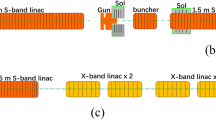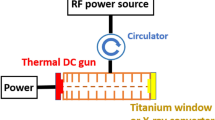Abstract
X-band high-gradient linear accelerators are a challenging and attractive technology for compact electron linear-accelerator facilities. The Very Compact Inverse Compton Scattering Gamma-ray Source (VIGAS) program at Tsinghua University will utilize X-band high-gradient accelerating structures to boost the electron beam from 50 to 350 MeV over a short distance. A constant-impedance traveling-wave structure consisting of 72 cells working in the 2π/3 mode was designed and fabricated for this project. Precise tuning and detailed measurements were successfully applied to the structure. After 180 h of conditioning in the Tsinghua high-power test stand, the structure reached a target gradient of 80 MV/m. The breakdown rate versus gradient of this structure was measured and analyzed.














Similar content being viewed by others
References
H. Chen, Y. Du, L. Yan et al., Optimization of the compact gamma-ray source based on inverse Compton scattering design. 2018 IEEE Advanced Accelerator Concepts Workshop (AAC), 1–5 (2018). https://doi.org/10.1109/AAC.2018.8659417
L. Zheng, Y. Du, Z. Zhang et al., Development of S-band photocathode RF guns at Tsinghua University. Nucl. Instrum. Methods Phys. Res. Sect. A. 834, 98–107 (2016). https://doi.org/10.1016/j.nima.2016.07.015
D. Cao, J. Shi, H. Zha et al., Electromagnetic and mechanical design of high gradient S-band accelerator in TTX, in 13th Symposium on Accelerator Physics (2018)
K. Abe, S. C. Joshi, T. Yamamura et al., GLC project: Linear collider for TeV physics (2003)
T. Higo, Y. Higashi, S. Matsumoto et al., Advances in X-band TW Accelerator Structures Operating in the 100 MV/m Regime, in Conf. Proc. C100523: THPEA013, 2010, SLAC National Accelerator Lab., Menlo Park, CA (United States) (2012)
A. Larsen, The Next Linear Collider Design: NLC 2001, SLAC National Accelerator Lab., Menlo Park, CA (United States) (2001)
J. Wang, Accelerator structure development for NLC/GLC, Stanford Linear Accelerator Center, Menlo Park, CA (US) (2004)
C. Adolphsen, Normal-conducting RF structure test facilities and results. Proceedings of the 2003 Particle Accelerator Conference, 1, 668–672 (2003) https://doi.org/10.1109/PAC.2003.1289005
T. Higo, M. Akemoto, A. Enomoto et al., High gradient study at KEK on X-band accelerator structure for linear collider. Proceedings of the 2005 Particle Accelerator Conference, 1162–1164 (2005). https://doi.org/10.1109/PAC.2005.1590694
S. Döbert, Status and future prospects of CLIC. Proceedings of LINAC08, Victoria, BC, Canada (2009)
J. Beijers, S. Brandenburg, K. Eikema et al., ZFEL: A Compact, Soft X-ray FEL in the Netherlands, in Proceedings of FEL Malmö Sweden (2010)
Y. Sun, C. Adolphsen, C. Limborg-Deprey et al., Low-charge, hard X-ray free electron laser driven with an X-band injector and accelerator. Phys. Rev. ST Accel. Beams 15, 030703 (2012). https://doi.org/10.1103/PhysRevSTAB.15.030703
X. Huang, W. Fang, Q. Gu et al., Design of an X-band accelerating structure using a newly developed structural optimization procedure. Nucl. Instrum. Meth. A 854, 45–52 (2017). https://doi.org/10.1016/j.nima.2017.02.050
T. Lucas, Smart*light, current activities and future concepts, in International Workshop on Breakdown Science and High Gradient Technology (2021)
X. Wu, H. Zha, J. Shi et al., Design, fabrication, and high-gradient testing of X-band choke-mode damped structures. Phys. Rev. ST Accel. Beams 22, 031001 (2019). https://doi.org/10.1103/PhysRevAccelBeams.22.031001
M. Peng, J. Shi, H. Zha et al., Development and high-gradient test of a two-half accelerator structure. Nucl. Sci. Tech. 32, 60 (2021). https://doi.org/10.1007/s41365-021-00895-x
L. Zhou, H. Zha, J. Shi et al., Development of a high-gradient X-band RF gun with replaceable field emission cathodes for RF breakdown studies. Nucl. Instrum. Meth. A 1027, 166206 (2022). https://doi.org/10.1016/j.nima.2021.166206
J. Liu, J. Shi, A. Grudiev et al., Analytic RF design of a linear accelerator with a SLED-I type RF pulse compressor. Nucl. Sci. Tech. 31, 107 (2020). https://doi.org/10.1007/s41365-020-00815-5
Z. Farkas, H. Hoag, P. B. Wilson et al., SLED: A Method of Doubling SLAC's Energy, in 9th International Conference on High-Energy Accelerators (1974).
W. Fang, D. Tong, Q. Gu et al., Design and experimental study of a C-band traveling-wave accelerating structure. Chin. Sci. Bull. 56, 18–23 (2011). https://doi.org/10.1007/s11434-010-4265-2
T. Khabiboulline, V. Puntus, R. M. Dohlus et al., A new tuning method for traveling wave structures, in Proceedings Particle Accelerator Conference, 1666–1668 (1995). https://doi.org/10.1109/PAC.1995.505321
R.H. Fowler, L. Nordheim, Electron emission in intense electric fields. 119, 173-181 (1928). https://doi.org/10.1098/rspa.1928.0091
J. Shi, A. Grudiev, W. Wuensch, Tuning of X-band traveling-wave accelerating structures. Nucl. Instrum. Meth. A 704, 14–18 (2013). https://doi.org/10.1016/j.nima.2012.11.182
C.W. Steele, A nonresonant perturbation theory. IEEE Trans. Microwave Theory Tech. 14, 70–74 (1966). https://doi.org/10.1109/TMTT.1966.1126168
W. Fan, A. Lu, L. L. Wai et al., Mixed-mode S-parameter characterisation of differential structures, in Proceedings of the 5th Electronics Packaging Technology Conference (EPTC 2003) (2003). https://doi.org/10.1109/EPTC.2003.1271579
J. Shi, Dissertation, Tsinghua University, 2009 (in Chinese)
X. Tao, D. Tong, A pass band performance simulation code of coupled cavities. in 22nd International Linear Accelerator Conference (2004).
P. Wang, J.-R. Shi, Z.-F. **ong et al., Novel method to measure unloaded quality factor of resonant cavities at room temperature. Nucl. Sci. Tech. 29, 50 (2018). https://doi.org/10.1007/s41365-018-0383-3
F. Liu, J. Shi, H. Zha et al., Development of a compact X-band variable-ratio RF power splitter. Nucl. Instrum. Meth. A 1015, 165759 (2021). https://doi.org/10.1016/j.nima.2021.165759
X. Meng, J. Shi, H. Zha et al., Development of high-power S-band load. Nucl. Instrum. Meth. A 927, 209–213 (2019). https://doi.org/10.1016/j.nima.2019.02.002
Y. Jiang, H. Zha, J. Shi et al., A compact X-band microwave pulse compressor using a corrugated cylindrical cavity. IEEE Trans. Microwave Theory Tech. 69, 1586–1593 (2021). https://doi.org/10.1109/TMTT.2021.3053913
D. P. Pritzkau, Dissertation, Stanford University, 2001
W. Wuensch, A. Degiovanni, S. Calatroni et al., Statistics of vacuum breakdown in the high-gradient and low-rate regime. Phys. Rev. ST Accel. Beams 20, 011007 (2017). https://doi.org/10.1103/PhysRevAccelBeams.20.011007
Author information
Authors and Affiliations
Contributions
All the authors contributed to the conception and design of the study. Material preparation, data collection, and analysis were performed by **an-Cai Lin, Liu-Yuan Zhou, Qiang Gao, Jian Gao, and Jia-Yang Liu. The first draft of the manuscript was written by **an-Cai Lin, and all the authors commented on the previous versions of the manuscript. All authors have read and approved the final manuscript.
Corresponding author
Additional information
This work was supported by the National Natural Science Foundation of China (Nos. 11922504 and 12027902).
Rights and permissions
Springer Nature or its licensor holds exclusive rights to this article under a publishing agreement with the author(s) or other rightsholder(s); author self-archiving of the accepted manuscript version of this article is solely governed by the terms of such publishing agreement and applicable law.
About this article
Cite this article
Lin, XC., Zha, H., Shi, JR. et al. Fabrication, tuning, and high-gradient testing of an X-band traveling-wave accelerating structure for VIGAS. NUCL SCI TECH 33, 102 (2022). https://doi.org/10.1007/s41365-022-01086-y
Received:
Revised:
Accepted:
Published:
DOI: https://doi.org/10.1007/s41365-022-01086-y




